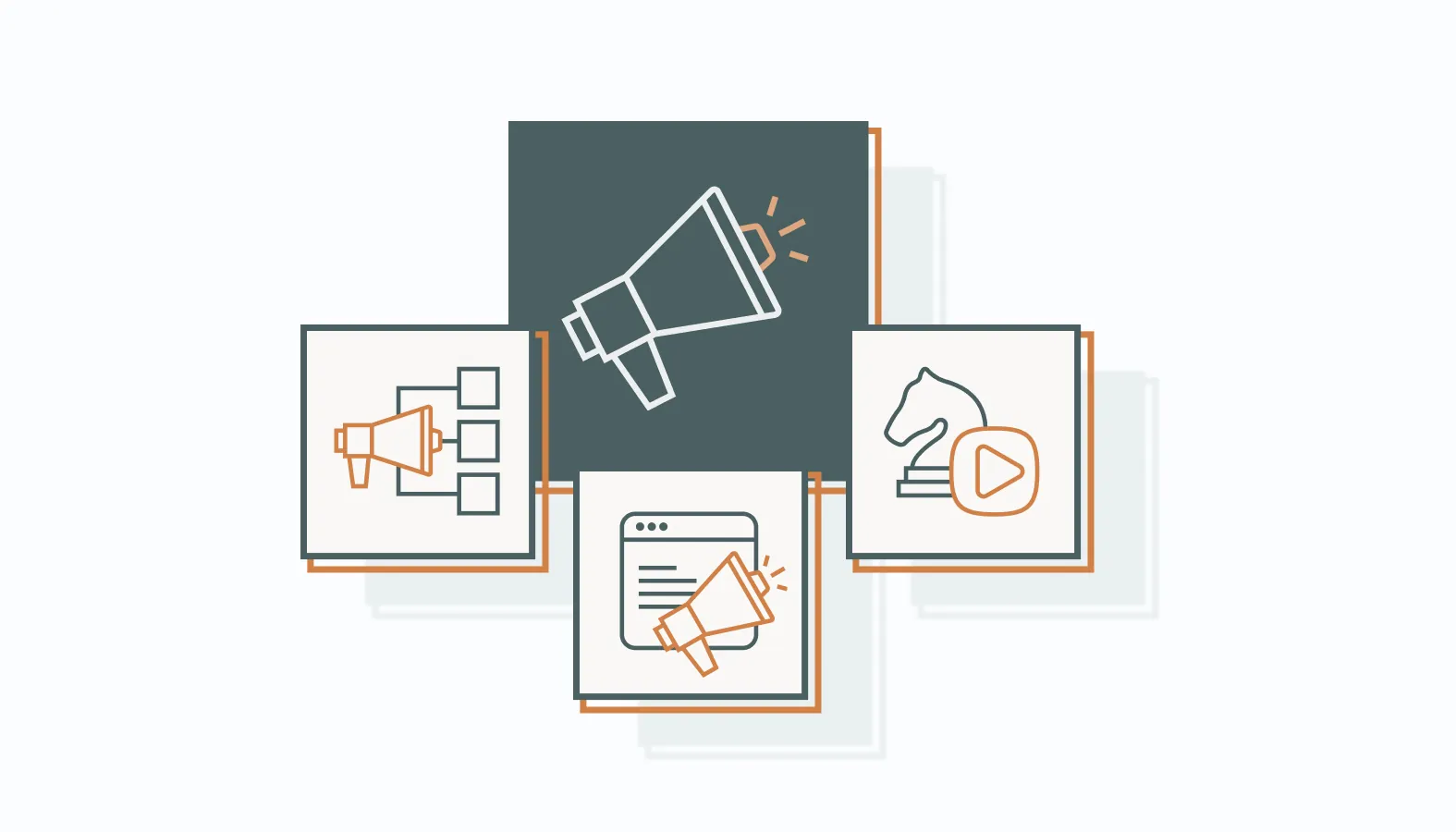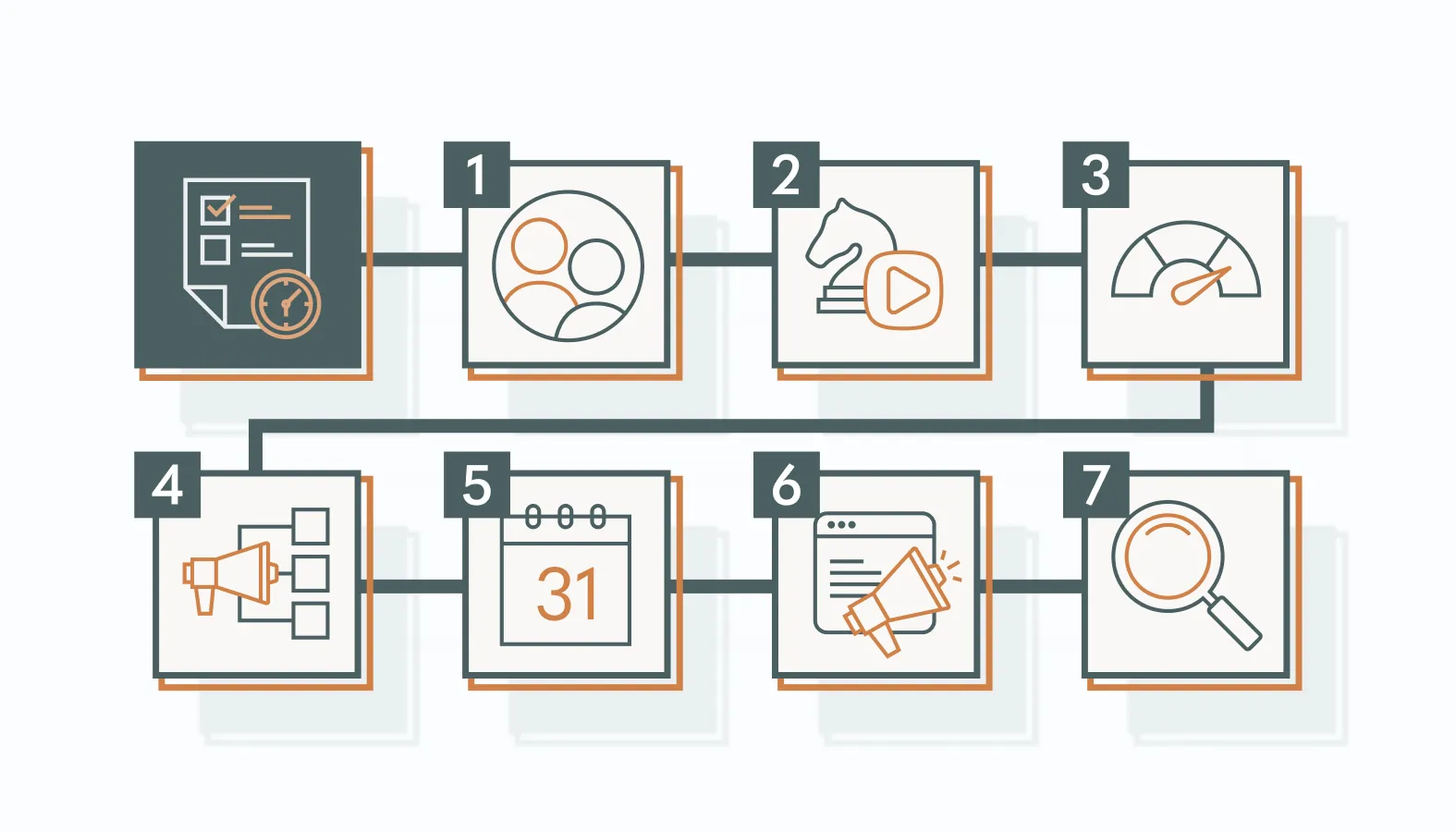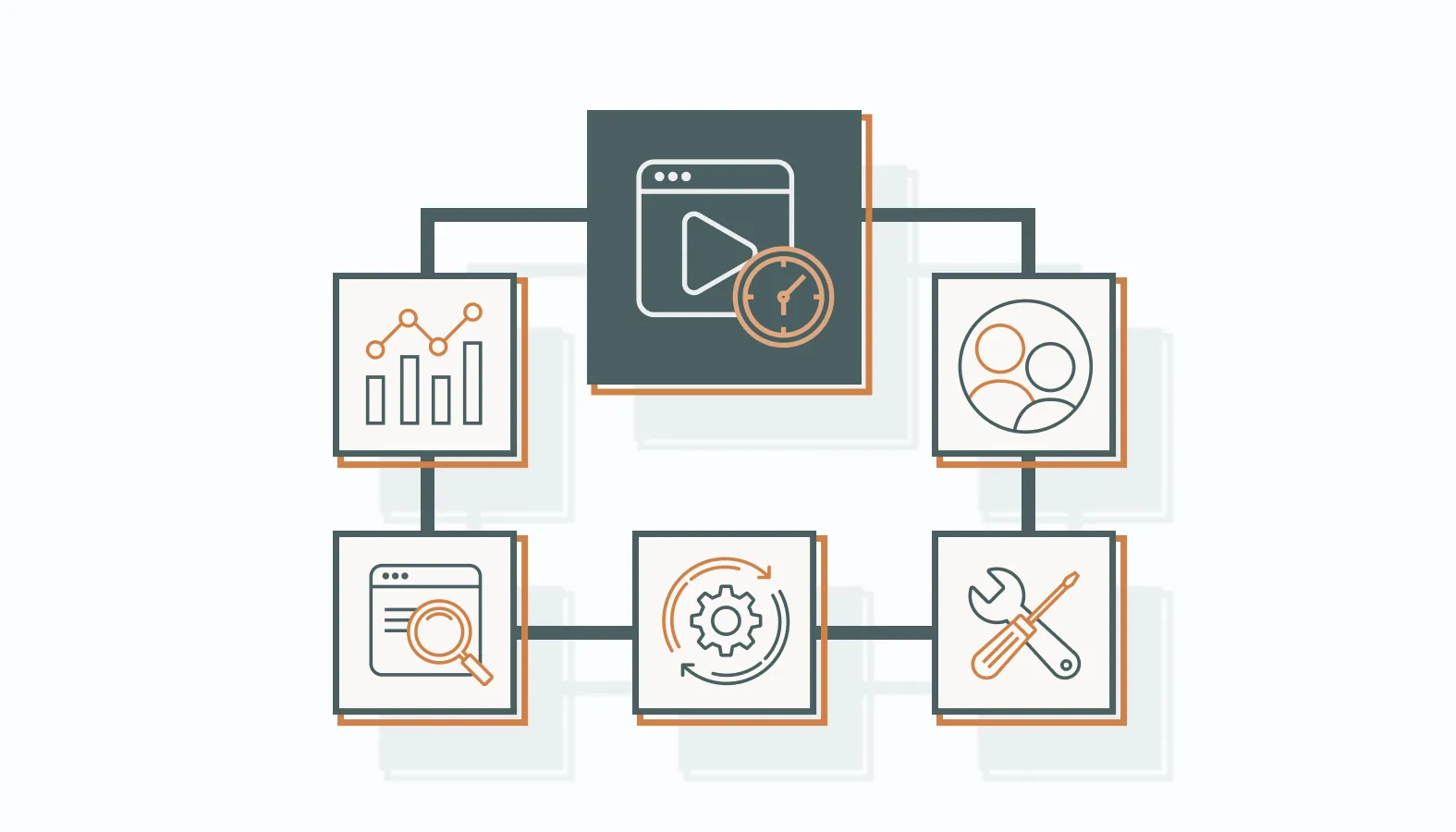Content creation is only half the job. Distribution is where performance happens.
Too often, teams share content last-minute or drop it into one channel and cross their fingers. That reactive approach wastes effort and caps your results before they start.
A strong content distribution strategy removes the uncertainty. It connects your work to the right audience, through the right channels, at the right time — all while reinforcing your broader marketing goals.
If your content performs well on paper but disappears after launch, the issue isn’t the message. It’s the system.
Here’s how to build a distribution engine that actually delivers.
What is Content Distribution?
Content distribution is the strategic process of sharing, publishing, and promoting your content through various channels to reach your target audience.
It’s not just about hitting “publish” and hoping for the best. Instead, content distribution is a deliberate, strategic effort to get your assets — whether blog posts, videos, infographics, podcasts, or social media updates — in front of the right people, at the right time, on the platforms they frequent most.
Why does this matter? Because content that lives in isolation doesn’t perform.
In today’s attention economy, reach doesn’t happen by accident. If you want content to generate impact, you need a system that delivers it with purpose.
Effective distribution connects your content to business outcomes. It ensures your brand appears in the right places and assigns a clear role to every asset within your broader strategy.
Why You Need a Content Distribution Strategy
Publishing without a strategy is just hope in disguise. A focused approach turns content into a lever for visibility, engagement, and revenue. Here’s how:
Gain Greater Visibility
If no one sees your content, nothing else matters.
A strong distribution strategy gets it in front of the right people by combining owned, earned, and paid channels.
You’re analyzing where your audience actually spends time, leaning into those platforms, and reworking your assets across formats, turning a single blog post into a video, a carousel, or a newsletter snippet.
Visibility isn’t left to chance. It’s engineered.
Boost Audience Engagement
Traffic is nice, but engagement moves the needle.
When you tailor delivery to each platform and audience segment, you create room for interaction: clicks, shares, comments, responses.
Add in polls, CTAs, or user-generated content, and now you’re not just talking at your audience, you’re talking with them. That kind of momentum builds brand loyalty and keeps people coming back.
Achieve Better ROI
Every content move should tie back to results. That means tracking what’s working, cutting what isn’t, and doubling down on channels that convert.
You’re not here for empty reach. You’re here for pipeline, retention, awareness, or whatever moves your business forward.
A smart strategy keeps your content out of the cost column and firmly in the growth engine.
Different Types of Content
A strong content distribution strategy starts with knowing your content options. Different formats serve different purposes, engage different minds, and unlock access to new platforms.
A diversified content mix enables you to speak to broader audiences, tailor your delivery, and meet people where they are.
Here’s how each type earns its place in your strategy.
1) Engaging Blog Posts
Blogs still pull weight, but only if they’re easy to find and worth the read.
To make your blog posts discoverable and valuable:
- Keyword Research: Identify primary and secondary keywords your audience is searching for, and weave them naturally into titles, headers, and body text.
- SEO Fundamentals: Use descriptive meta titles and meta descriptions, include alt text for images, and structure content with H2s and H3s for readability.
- Internal & External Links: Link to relevant internal articles and credible external sources to enhance authority.
- Value-Driven Content: Focus on actionable, insightful information that answers real questions or solves actual problems for your readers.
When optimized right, blogs become lead-in points for organic traffic, backlinks, and deeper engagement.
2) Impactful Videos
Video stops the scroll. But to keep attention, every second has to earn it.
Strong video content follows a few rules:
- Start Strong: Hook viewers in the first few seconds with a captivating intro, provocative question, or visual punch.
- Keep It Concise: Respect your audience’s time. Short, focused videos often outperform lengthy ones.
- Clear Visuals & Audio: Invest in good lighting, clear sound, and crisp visuals. Production quality directly impacts perceived credibility.
- Include CTAs: Guide viewers on what to do next: subscribe, comment, visit your site, or share.
Done well, videos scale across YouTube, LinkedIn, Instagram, and more, reaching audiences who prefer to watch rather than read.
3) Informative Infographics
Infographics give shape to complex data and help ideas stick faster.
To build effective visuals:
- Simplify: Avoid clutter. Use white space and clear sections for each data point or idea.
- Use Visual Hierarchy: Highlight key stats or takeaways with larger fonts or bold colors.
- Commit to Brand Consistency: Stick to your brand’s color palette, fonts, and logo to reinforce recognition.
- Cite Sources: Boost credibility by referencing where your data comes from.
Well-designed infographics are versatile and often earn organic shares and backlinks across multiple platforms.
4) Engaging Podcasts
Podcasts create space for depth, personality, and real connection.
To expand reach through audio:
- Distribute Widely: Use platforms like Apple Podcasts, Spotify, Google Podcasts, and niche directories.
- Consistent Scheduling: Release episodes regularly to establish habits with your listeners.
- Guest Appearances: Feature industry experts or influencers to tap into their audiences and boost credibility.
- Transcripts & Show Notes: Add these to your website for SEO benefits and accessibility.
With the right voice and smart distribution, podcasts build loyal followings that keep tuning in.
5) Effective Social Media Posts
Social media isn’t one-size-fits-all. Each platform has its own language, culture, and best practices. Winning content plays to each one’s strengths.
Here’s how to tailor with purpose:
- Platform Fit: Use visuals and short text for Instagram, thought leadership on LinkedIn, trending topics on X (formerly Twitter), and behind-the-scenes on Facebook or TikTok.
- Engagement Prompts: Ask questions, run polls, or encourage sharing to spark conversations.
- Consistency: Post regularly and at optimal times when your audience is most active.
- Brand Voice: Maintain a consistent tone and style, but flex slightly to fit the platform’s vibe.
By meeting your audience where they are, and how they like to interact, you amplify your content’s impact.
6) Targeted Email Campaigns
Email works when it’s personal, timely, and valuable. Blasts don’t cut it.
Key ways to improve email ROI:
- Audience Segmentation: Group subscribers by interests, behavior, or demographics to send the most relevant content.
- Personalization: Use names, tailor subject lines, and serve content based on past engagement.
- Compelling CTAs: Tell recipients exactly what you want them to do: download, reply, register, or shop.
- A/B Testing: Experiment with subject lines, send times, and content to optimize performance.
When emails feel tailored and relevant, they become relationship builders and revenue drivers.
Diversifying content gives your distribution strategy the flexibility it needs. Each format opens new doors, helps you connect more effectively, and ensures your message travels farther and lands better.
Navigating Content Distribution Channels
An effective content distribution strategy begins with selecting the optimal combination of channels. Each serves a distinct role, providing broad visibility, building trust, or achieving laser-targeted reach. Mastering how to use them together is what makes your content truly effective.
Let’s break down the three core types — owned, earned, and paid — and how to use each to maximize impact.
1) Owned Distribution Channels
Owned channels are your digital home base. These include your website, blog, email list, and social profiles. You control the narrative, the experience, and the timing.
Why owned channels matter:
- Full Autonomy: You call the shots. What you say, when you say it, and how often.
- Brand Consistency: Messaging, visuals, tone—fully aligned with your brand DNA.
- Data Ownership: You collect the data. That means better targeting and sharper decisions.
To get the most from owned media:
- Keep your website and blog updated with SEO-driven, valuable content.
- Build your email list and personalize campaigns to increase engagement.
- Post regularly on each social platform, optimizing content per channel.
Owned channels build the foundation. They’re where your message starts and your audience deepens trust.
2) Earned Content Distribution
Earned channels are all about third-party validation; publicity you haven’t paid for but have, well, “earned.” This includes organic media coverage, guest posts, product reviews, social shares, and backlinks from authoritative sites.
Here’s how to earn it:
- Pitch with Purpose: Share real insights, compelling data, or strong narratives with journalists and bloggers.
- Inspire User Content: Run contests, challenges, or spotlight campaigns that get your audience involved.
- Contribute Thoughtfully: Write guest posts or speak on podcasts your target audience already trusts.
Why it works:
- Credibility: A third party saying you’re great beats saying it yourself.
- Extended Reach: Their audience becomes your audience.
- SEO Fuel: Authoritative backlinks push your rankings higher.
Example: A startup releases a study, lands in TechCrunch, and watches traffic spike. Or a smart infographic earns influencer shares and drives new leads.
3) Paid Content Distribution
Paid channels fast-track your reach. Whether it’s search ads, social sponsorships, or influencer collaborations, they get your message in front of the right audience fast.
Pay-Per-Click (PPC) Ads
PPC ads let you pay only when someone clicks on your content, a cost-effective way to drive qualified traffic.
What makes PPC valuable:
- Immediate visibility on search engines or social platforms.
- Laser-focused targeting by demographics, interests, or search intent.
- Scalable budgets. You control spend and can ramp up based on results.
Tips for successful PPC campaigns:
- Start with strong keyword research to target high-intent queries.
- Write compelling ad copy and use eye-catching visuals.
- Monitor performance closely and optimize bids, targeting, and creative elements regularly.
Sponsored Content
This is content you pay to publish on a third-party platform, often styled to match the publisher’s editorial tone.
Benefits include:
- Trusted exposure in someone else’s digital real estate.
- Builds credibility through association with respected publications or platforms.
- Drives targeted traffic and potential leads from aligned audiences.
Strategies for impactful sponsored content:
- Choose partners whose audience matches your customer profile.
- Create value-driven, non-salesy content that educates or entertains.
- Use clear calls to action and track performance with UTM parameters or unique landing pages.
Influencer Partnerships
Influencer partnerships leverage the credibility and reach of individuals who have built loyal followings in your industry.
Why influencer distribution works:
- Instantly tap into established, engaged communities.
- Humanize your brand and build trust via authentic recommendations.
- Generate buzz and social proof, especially for product launches or campaigns.
How to choose the right partner:
- Prioritize relevance over follower count. Look for alignment in values, audience, and content style.
- Analyze past engagement rates and authenticity.
- Set clear expectations and goals for the partnership.
Owned, earned, and paid channels each bring something different to the table. Combined, they form a resilient distribution system that helps your content reach further, land more effectively, and convert better.
Crafting a Successful Content Distribution Plan
A winning content distribution plan aligns with your broader marketing goals and maximizes the value of every content asset, from ideation to performance review.
Step 1: Understand Your Audience
Get precise about who you’re targeting. Your distribution becomes more effective when you know who they are and what matters most.
- Analyze analytics from your site and social channels to identify demographics and behaviors.
- Conduct surveys or interviews to gather direct feedback from your audience about the content they value.
- Monitor forums or social communities for insights on the content they engage with.
Once you have your list of audience, group them by demographics (age, location, job role), behaviors (purchasing habits, content engagement), or psychographics (values, interests). Then, tailor your messaging and channel selection for maximum impact.
Step 2: Evaluate Existing Content
Before you crank out new content, audit what you’ve already produced.
How to conduct a content audit:
- Inventory all existing assets (blog posts, videos, whitepapers, etc.).
- Assess each piece for quality, relevance, and performance (traffic, shares, leads generated).
- Identify gaps or topics you haven’t covered, outdated material, or assets that could be improved.
Then, find opportunities for improvement by:
- Repurposing high-performing blog posts into videos, infographics, or podcasts.
- Refreshing stats, visuals, and calls-to-action in evergreen content.
- Remove or consolidating underperforming or irrelevant pieces to streamline your library.
Step 3: Define Your Goals and KPIs
Every strategy needs direction. Set clear goals and match them to measurable KPIs.
Creat SMART (Specific, Measurable, Achievable, Relevant, Time-bound) goals that reflect business objectives like awareness or sales.
Align KPIs (key performance indicators) with your goals. For example, traffic for awareness, shares for engagement, or leads for acquisition.
To select KPIs, choose metrics that match your goals, such as:
- Website traffic or session duration for awareness
- Social shares and comments for engagement
- Leads generated or conversion rates for acquisition
- Email open and click-through rates for nurturing
Step 4: Identify the Right Channels
Not all channels are created equal and not every channel is right for your audience or content type. Pick channels that your audience uses and that fit your content type.
- Use your audience research to uncover where your segments spend time (LinkedIn for B2B, Instagram or TikTok for Gen Z, etc.).
- Match content format to channel (videos for YouTube, thought leadership for LinkedIn, visuals for Pinterest).
- Test and refine. Start with a few channels, then double down on what delivers results.
- Map out your segments and prioritize the channels they trust and use most frequently.
Step 5: Plan with a Content Calendar
A content calendar brings order to chaos. It keeps your team organized, ensures strategic timing, and helps you spot gaps before they become problems.
Advantages of a content calendar:
- Visualizes your distribution plan at a glance.
- Coordinates campaigns, launches, and key dates across teams.
- Prevents last-minute scrambles and inconsistent posting.
Use tools like Trello, Asana, or dedicated content calendar platforms to schedule and plan posts by channel, date, topic, and responsible team member. Keep space open for timely or reactive content as trends emerge.
Step 6: Create and Distribute Content
With your strategy mapped out, it’s time to execute. This is where strategy becomes traction.
- Maintain quality. Prioritize substance and clarity over quantity.
- Adapt messaging and format to each channel and audience segment.
- Incorporate strong calls-to-action to guide next steps.
To distribute like a pro, use scheduling tools to automate posting and ensure coverage across time zones. Cross-promote content on multiple platforms where relevant, and encourage team members and partners to share content for wider reach.
Step 7: Monitor and Optimize
Distribution is not “set it and forget it.” The best teams constantly analyze and improve.
- Track performance with analytics tools like Google Analytics, social insights, email platforms.
- Monitor real-time feedback, such as comments, shares, email replies, for qualitative insights.
- Double down on channels, formats, and topics that perform best.
- Tweak underperforming content or distribution timing.
- Regularly review and update your plan to stay ahead of market shifts and audience trends.
By following these steps — from audience insight to continuous optimization — you’ll build a distribution strategy that aligns with objectives and delivers lasting business impact.
Tools and Platforms for Distribution
A strong content distribution strategy relies on the right tools. Modern marketers have access to platforms that automate workflows, expand reach, and provide detailed performance insights.
Whether you’re scheduling social posts, launching email campaigns, or publishing video content, using the right mix of tools will streamline operations and keep your strategy agile.
Here’s a breakdown of platforms that deserve a spot in your content distribution stack.
Hootsuite
Hootsuite is a powerhouse for managing multiple social media accounts from a single dashboard. Whether you’re juggling two channels or ten, Hootsuite’s intuitive interface lets you schedule posts, monitor conversations, and track performance metrics, all in one place.
Key features:
- Bulk scheduling across platforms like Facebook, X (Twitter), LinkedIn, and Instagram.
- Real-time monitoring of brand mentions and keyword tracking.
- In-depth analytics to measure engagement and optimize future campaigns.
Practical tips:
- Use the auto-scheduling feature to post at times when your audience is most active.
- Set up streams for competitor monitoring and industry trends to stay ahead.
- Regularly review analytics reports to refine your content approach and boost engagement.
Buffer
Buffer focuses on clean execution and user experience. It’s fast, intuitive, and great for solo marketers or lean teams.
Advantages:
- Queue up posts for multiple platforms in just a few clicks.
- Access visual calendar views for long-term planning.
- Built-in analytics help pinpoint the best times and types of content for your audience.
Optimization strategies:
- Use Buffer’s “Best Time to Post” suggestions to maximize reach.
- Experiment with different post formats and analyze which generate the most engagement.
- Tap into Buffer’s browser extension to quickly add content to your queue as you browse the web.
Mailchimp
Mailchimp leads the way in email marketing with easy-to-use tools and deep automation.
Capabilities:
- Create beautiful, mobile-responsive emails with pre-designed templates.
- Segment lists by behavior, demographics, or engagement to send targeted messages.
- Automation workflows let you trigger emails based on user actions, such as sign-ups or purchases.
Streamlining with automation:
- Set up automated welcome sequences to onboard new subscribers.
- Personalize campaigns with dynamic content blocks based on user data.
- Use A/B testing to refine subject lines, send times, and messaging for better results.
WordPress
WordPress is the standard for content management for good reason. It’s flexible, customizable, and easy to scale.
Strengths:
- Easily create, publish, and organize content with intuitive tools.
- Customize your site with thousands of themes and plugins for SEO, performance, and integrations.
- Robust user roles and permissions enable efficient team collaboration.
Tips for efficiency:
- Use SEO plugins like Yoast or Rank Math to optimize every post for search engines.
- Leverage scheduling features to plan and automate content publishing.
- Regularly update plugins and themes to keep your site secure and running smoothly.
YouTube
YouTube remains the leading platform for growing an audience with video content. It’s equal parts search engine, social network, and branding engine.
Growth strategies:
- Optimize video titles, descriptions, and tags with relevant keywords.
- Create compelling thumbnails and use playlists to keep viewers engaged.
- Engage with your audience by responding to comments and encouraging subscriptions.
Monetization opportunities:
- Enable AdSense for ad revenue.
- Promote products or services within your videos.
- Collaborate with other creators to expand your reach.
Vimeo
Vimeo caters to creators who prioritize control, quality, and presentation. It’s ideal for branded content and internal use cases.
Unique features:
- Advanced privacy settings (password protection, domain-level privacy).
- Customizable video players and brand integrations.
- High-quality, ad-free playback ideal for B2B, creative portfolios, or gated content.
Effective use cases:
- Host gated webinars or training videos for premium audiences.
- Share private product demos with select stakeholders.
- Deliver high-impact video portfolios to niche audiences.
Anchor
Anchor simplifies podcasting with an all-in-one toolset for recording, editing, and distribution. No fancy equipment needed.
Tools for creators:
- Record audio directly in the app or upload pre-recorded files.
- Add background music, transitions, and episode segments easily.
- Monetization options like listener support and sponsorships.
Maximizing distribution:
- With one click, Anchor distributes your podcast to Spotify, Apple Podcasts, and more.
- Built-in analytics let you track listens, retention, and audience demographics.
Libsyn
Libsyn (short for Liberated Syndication) is a reliable podcast host with deep analytics and monetization options. It’s designed for serious podcasters with growing audiences.
Advantages:
- Scalable hosting for podcasts of all sizes.
- Detailed analytics on downloads, audience locations, and platform performance.
- Monetization tools, including dynamic ad insertion and subscription options.
Insights for growth:
- Use promotional tools to automatically publish episodes to social media and podcast directories.
- Analyze listener data to refine topics and episode length.
- Experiment with premium content and advertising to diversify revenue streams.
Integrating these tools into your distribution workflow gives you more control, sharper insight, and scalable efficiency. When each tool works in sync, your strategy shifts from manual hustle to high-performance marketing engine.
Implementing Best Practices for Distribution
Effective content distribution isn’t static. Platforms shift, audiences evolve, and formats change. The strategies that last are the ones that adapt.
When you apply best practices with precision and stay tuned into your audience and market, content distribution becomes a reliable engine for long-term growth.
1) Understand Your Audience’s Needs
If you want content to connect, start with clarity on what your audience actually wants—pain points, formats, and everything in between.
Methods for gaining insights:
- Surveys and Polls: Ask directly what your audience values and struggles with.
- Behavioral Analytics: Tools like Google Analytics, Hotjar, and social insights show what earns attention and why.
- Social Listening: Watch niche conversations, hashtags, and emerging trends to track demand in real time.
Tailoring content:
- Segment based on demographics, interests, and behaviors, then personalize accordingly.
- Adapt voice, visuals, and format for each platform and audience segment.
- Update buyer personas regularly to reflect shifting expectations and priorities.
2) Utilize Multiple Platforms
Single-channel distribution is obsolete. Your audience is everywhere, and your content should be too.
Advantages of a multi-platform approach:
- Expanded Reach: Different platforms bring in different audiences.
- Content Repurposing: One asset becomes five: blogs into reels, infographics, emails, and more.
- Risk Mitigation: A shift in one platform’s algorithm won’t stall your entire strategy.
Pro tip: Customize for each platform. Copy-paste content looks lazy and misses the mark.
3) Be Consistent
If you want lasting attention, show up on schedule. Consistency builds trust, recognition, and platform favor.
Why consistency matters:
- Builds Anticipation: Regular cadence keeps your audience returning.
- Supports Algorithms: Frequency feeds visibility.
- Reinforces Brand Identity: Repetition strengthens brand recall and authority.
Maintaining brand consistency:
- Build a style guide to unify tone, visuals, and messaging.
- Use scheduling tools to keep publishing on track.
- Align your team to one brand voice. Every touchpoint should sound like you.
4) Utilize SEO Techniques
SEO supports discovery across every channel, not just your website. It’s a multiplier when done right.
Integrating SEO:
- Start with keyword research for each asset. Optimize titles, meta descriptions, and content structure.
- Use SEO across platforms: video tags on YouTube, image text on Pinterest, and show notes in podcasts.
- Prioritize mobile optimization, load time, and accessibility to stay visible and competitive.
Improving search visibility:
- Build backlinks through partnerships, guest posts, and shareable visuals.
- Structure content clearly with strong headlines, links, and readable URLs.
- Keep evergreen content updated to maintain rankings and relevance over time.
5) Leverage Analytics
Analytics fuel decision-making. The numbers matter less than the story they tell and the action you take.
Tools for insights:
- Google Analytics: Understand site behavior and traffic sources.
- Social Platform Analytics: Track engagement, reach, and audience growth.
- Email Platforms: Monitor opens, clicks, and conversions through tools like HubSpot or Mailchimp.
Making informed decisions:
- Tie KPIs to business objectives, then monitor trends closely.
- Double down on what performs and cut what doesn’t.
- Run A/B tests to fine-tune everything from messaging to delivery timing.
Apply these practices with discipline and agility, and your content distribution strategy stays sharp and ready to evolve with your audience and outperform shifting trends.
Final Word: Build Distribution Like a Pro
Great content deserves more than a quiet launch. When your distribution strategy is precise, consistent, and audience-aware, it transforms content from an asset into a performance engine.
Here’s what to lock in:
- Strategic Alignment: Tie every distribution move to your marketing and business goals. Without direction, good content underperforms.
- Audience Intelligence: The sharper your audience insights, the smarter your targeting and the stronger your ROI.
- Channel Diversity: Don’t hedge on one channel. Use a mix of owned, earned, and paid platforms to stay visible and protected.
- Consistency with Agility: Keep your voice and cadence steady while staying nimble enough to adapt to platform shifts and audience changes.
- Data-Driven Refinement: Let analytics guide your next move. Constant testing and iteration keep you competitive and effective.
The brands that excel treat distribution as a disciplined practice. They invest in the right tools, listen to their data, and evolve with intention. Do the same, and content becomes more than visibility — it becomes revenue.
Let’s Talk Strategy That Delivers
If your content distribution feels reactive, scattered, or underperforming, it’s time to recalibrate.
We help brands cut through noise with sharp, scalable strategies backed by experience and results. No pitch. No jargon. Just an honest discussion with a team that knows how to make distribution work smarter.
Ready to get serious about reach, relevance, and ROI? Schedule a candid conversation with one of our experts. Let’s build something that performs.









